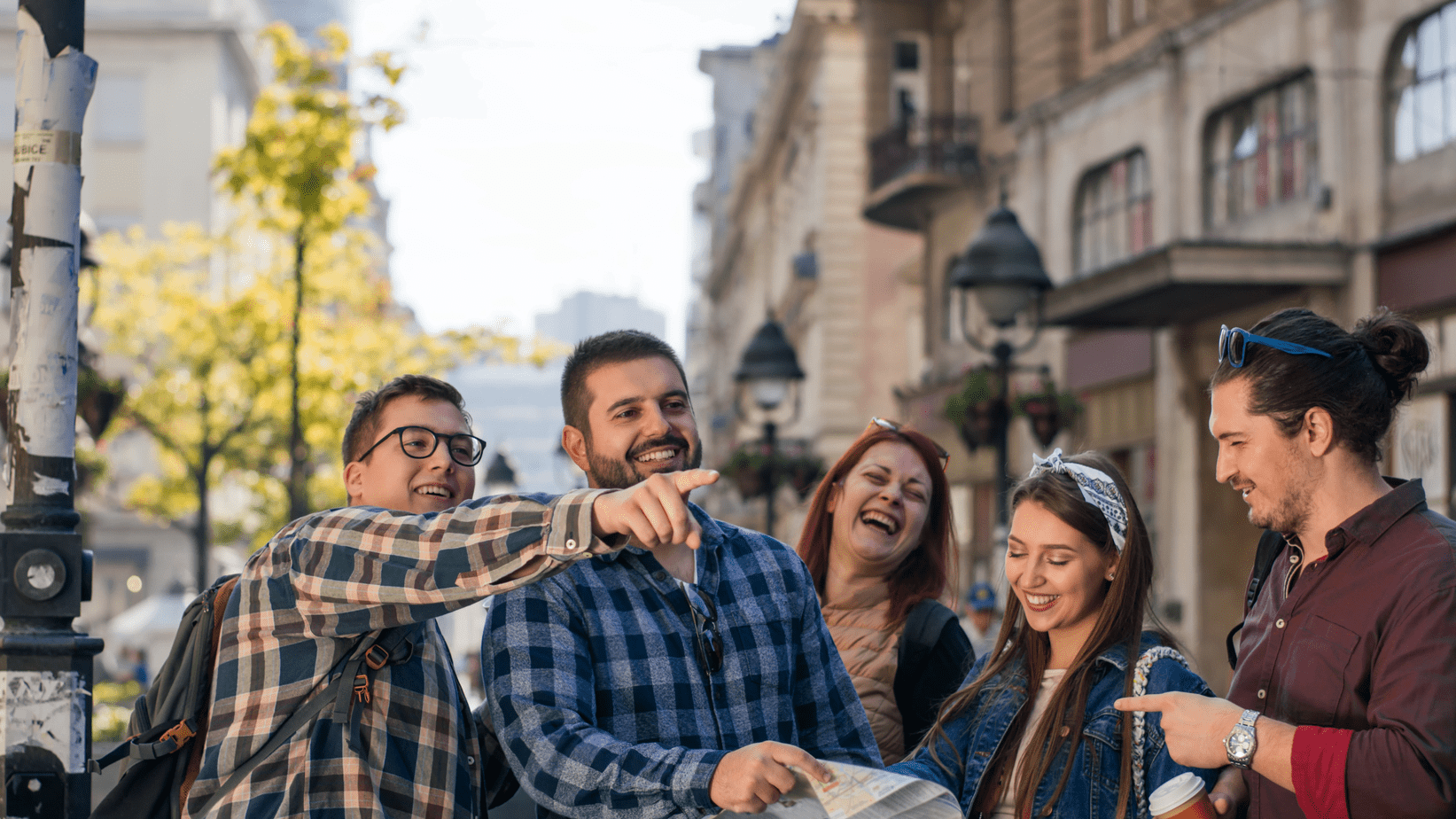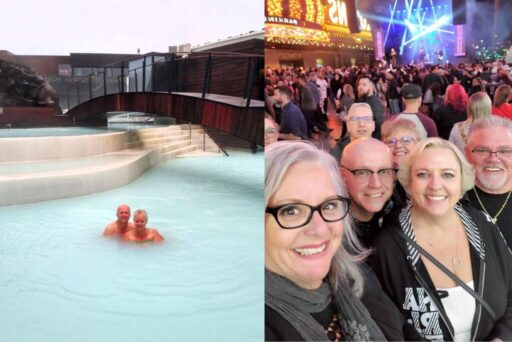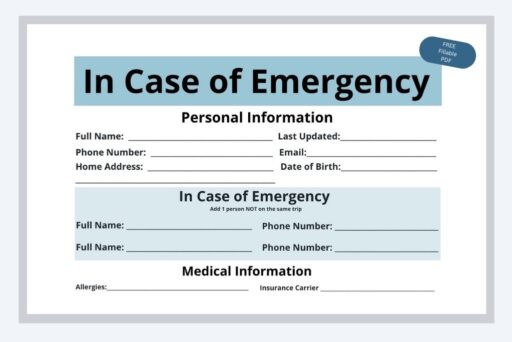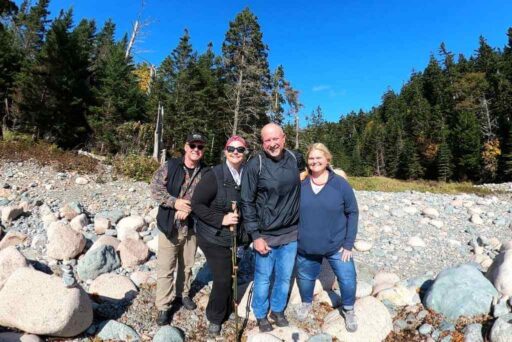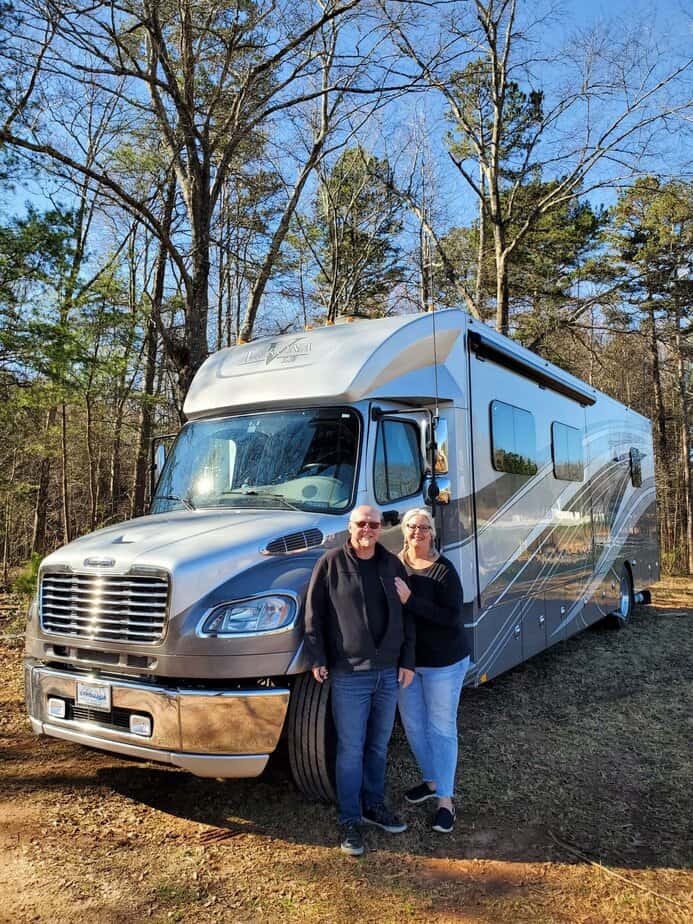
Updated 10/15/25
Learning how to plan a trip with friends isn’t just about picking a destination; it’s about protecting your peace, your budget, and your friendships.
I found this out the hard way on an early group trip. Let’s just say: it wasn’t relaxing, it wasn’t fun, and it nearly convinced me never to travel with friends again.
That experience taught me something important: you don’t just plan a trip, you plan how to travel together.
Group dynamics can shift fast. People you thought you knew act differently on vacation. Moods swing. Budgets clash. Someone wants to hike, someone else wants bottomless mimosas by the pool.
You don’t need to micromanage the fun, but you do need a shared plan.
This guide will help you:
- Stay organized
- Minimize conflict
- Keep your group aligned
- And most importantly… actually enjoy the people you’re traveling with
Because the goal isn’t just to go somewhere cool.
It’s to come home still loving your friends.
How to Plan a Trip with Friends (Without Losing Your Mind)
Planning a trip with friends can be one of the most joyful, hilarious, soul-filling experiences of your life, or a total disaster. The difference? A solid plan.
These steps are based on real-life trial and error (some of it painful), plus my experience as a travel agent and group trip planner. Follow them and you’ll set the stage for smoother logistics, fewer misunderstandings, and a whole lot more fun.
1. Set Intention and
Overall Vibe of the Trip
Stating the intent of the trip is the most important step.
Every other part of planning a trip with friends hinges on this step. Without it, you’re inviting missed expectations, awkward tension, and a whole lot of “I thought we were doing that.”
Every trip has a vibe. Maybe it’s meditation and mountain hikes. Maybe it’s mojitos and chaos. But if you don’t set that tone upfront, people can (and will) show up with clashing priorities.
A simple statement of intent, shared before anyone even books, helps people opt in or out. It also keeps you from spending half your trip in damage control mode.
I Thought We Were Going to Party…
A few years ago, I got invited on a girls’ “shopping trip.” I was still pretty new to the group, but it looked fun — in my mind, we’d be sipping wine, hitting boutiques, maybe even doing a little bar-hopping and late-night bonding.
That’s not what happened.
We went to a chain restaurant — Texas Roadhouse or something like it — and I don’t even remember if we all sat together. There was no vibe, no plan. Eventually, we ended up in one of the hotel rooms watching a movie. I came in late, didn’t know what was going on, and honestly… I was bored stiff.
So I slipped outside, grabbed a smoke, and went to bed.
I haven’t said yes to a girls’ trip since.
The problem wasn’t that the night was calm — it was that no one said it would be calm. If someone had just said, “This is a low-key weekend with early dinners and movies,” I might have skipped it — or at least managed my expectations.
That’s the power of intention.
What an Intention Statement Looks Like
So how do you avoid the chaos?
You get clear up front. Here are a few real-life examples of intention statements I now send before anyone books a flight:
- This is a spa retreat—a completely relaxing trip. There will be no bus tours and no shopping. This is a weekend to indulge in luxury spa treatments and have “girl talk.”
- We are going to craft all weekend at the annual Make a Craft Convention. This means “bring your soft pants and craft supplies”, not we’re going on a catamaran whale watching tour.
- Imagine being invited to a mountain cabin with your best friend, only to find out it’s a mastermind of entrepreneurs like her. Where you thought you’d be sipping wine and watching movies, you’re now trapped in whiteboards and business planning. This may sound far-fetched, but worse trips have happened.
Every adventure, whether a camping trip, a road trip, or a cruise, will have its own dynamic. Defining that before you pick dates or destinations protects friendships, preserves energy, and sets your trip up for genuine connection and fun.
From experience, I’ve been on some miserable trips simply because the intention was unclear. Don’t make the same mistake. Say the vibe out loud. Set the tone early. It changes everything.
2. Set a Realistic Budget
Money stress can kill the vibe of a trip fast.
Some people travel like they’ve got a black AmEx, while others budget down to the last dime. The trick is to plan something that feels comfortable and fair for everyone.
If you don’t talk about money openly before the trip, it will show up in other ways: frustration, resentment, withdrawal, or worst of all… total ghosting.
When the Budget Gap Gets Awkward
Robb and I aren’t cheap; we’re just mindful. We’re price-sensitive, not only to our own budget but also to our friends’. We’ve got friends who roll deep with big jobs and bigger salaries, and most of the time, we can hold our own.
Until the $70 shots of tequilla and $150 bottles of wine start showing up.
That’s when things get tricky.
We’re not trying to ruin anyone’s good time, but we can’t and won’t play on that level. And honestly, it can feel embarrassing, like you’re suddenly the “poor friends” in the group, even if no one says it out loud.
This is why setting a budget early matters so much. It’s not about limiting the fun — it’s about keeping everyone comfortable, respected, and included.
What to Budget For
Here are the categories every trip should plan around:
- Airfare or other transportation to the destination
- Lodging or accommodations
- Local transportation (Uber, rental car, public transit)
- Meals and drinks (group and solo)
- Entertainment and activities
- Optional excursions or upgrades
- Trip-specific gear or clothing
- Incidentals and “just in case” cash
Even if you don’t finalize exact numbers, talk about ranges.
Are we looking at a $500 trip or a $2,000 trip? Are we budgeting for daily activities or just one splurge?
Set the Tone as the Host
As the trip host, it’s on you to bring up the budget early and clearly.
You don’t need to dictate what everyone spends, but you do need to set expectations. If your friends can’t swing the vision you’re planning, they need the chance to opt out early, before it gets awkward.
👉 ProTip: Include optional upgrades in the itinerary and label them as such. That way, people don’t feel pressured, and no one has to sit out silently.
How I Handle Budget as a Trip Planner
As a travel agent and personal trip planner, I often ask my clients and friends the same simple question:
“What’s your comfortable budget?”
It sounds basic, but you’d be amazed at how many people avoid it and then are blindsided later.
When I know someone’s price comfort, I can build an itinerary around realistic expectations. That doesn’t mean no fun, it just means knowing where to splurge and where to save.
For instance, when we travel to Las Vegas with friends, we might skip overpriced bottle service in favor of an over-the-top dining experience.
Your group might be the opposite, and that’s totally fine.
Money and experiences are personal preferences, but talking about them early prevents those preferences from turning into problems.
Don’t Money Shame — Ever
Not everyone is in the same financial place, and that’s okay.
If someone can’t do the $300 winery tour, don’t guilt them.
Friendships can survive a lot, but money shame will quickly crack the foundation.
The better you communicate now, the more joy you’ll get from the trip later.
3. Identify the Group of Friends Traveling
Let’s get one thing straight: not every friend is a good travel friend.
And that’s okay.
Some people are fun over brunch, but not in a car for eight hours. Some thrive on spreadsheets and early hikes. Others want room service and bottomless mimosas. The key is to stop inviting people out of obligation and start matching the right people to the right trip.
Intention + People = Compatibility
This is where your trip intention does some heavy lifting.
If the goal is a peaceful spa retreat, your “Vegas till 4 a.m.” friend probably isn’t the best match.
If you’re hiking national parks, your shop-til-you-drop buddy may not love the itinerary.
The clearer you are about what kind of experience you’re curating, the easier it is for people to say yes — or opt out without guilt.
👉 ProTip: When you send the invite, include a brief description like:
“This is a quiet weekend in a mountain cabin with wine, movies, and hiking. It’s not a bar crawl or high-speed sightseeing weekend.”
Think Beyond the Invite List
Ask yourself:
- Who will actually enjoy this trip?
- Do their travel styles align — or conflict?
- How flexible are they when plans shift or things go wrong?
- Can they afford this comfortably — without stress or resentment?
It’s not personal. It’s logistical. A mismatched group turns even the best destination into a frustration loop.
Group Size Matters (More Than You Think)
The number of people you invite will shape everything from where you stay to what you do to how you communicate.
Big groups need dinner reservations, whereas small groups can wing it. Big groups struggle with transportation, while smaller groups can Uber and split it.
Every detail, from budget to bonding, flows from the group size. Too often, this part is left to chance.
Have you ever watched a bridal squad of 14 girls trying to stay together in a Vegas casino? No one looks happy. Not even the bride.
👉 ProTip: Consider booking an all-inclusive resort for groups larger than 8. These properties are designed for bigger gatherings. Resorts usually have built-in entertainment, multiple dining options, and plenty of seating areas, so the group doesn’t always have to stay glued together. There’s space to relax, party, or explore at your own pace.
For smaller groups of 2–8 people, snagging restaurant tables, navigating clubs, and splitting transportation between venues without chaos is easier.
Start With Clarity
Finalize your guest list early.
Collect everyone’s email and phone number in one place.
Communicate expectations clearly from the start.
Don’t be afraid to set a firm RSVP deadline.
A well-matched group = a well-loved trip.
Make this decision carefully; it’s the foundation for everything.
4. Create a Shared Itinerary
Even if you’re the go-with-the-flow type, group travel needs a plan. A shared itinerary gives everyone clarity, reduces confusion, and prevents the dreaded “So… what are we doing today?” at 9 a.m. in matching robes.
This isn’t about controlling every moment. It’s about making sure the trip you worked so hard to plan doesn’t feel chaotic once it starts.
Flexibility vs Structure
Not everyone in the group will want to do the same things, and that’s okay.
Build in anchor activities like a group dinner, a wine tasting, or a guided tour. Then leave room for optional adventures, naps, or solo time. The key is to offer structure with space, so everyone can participate without feeling pressured.
👉 ProTip: I like to ask everyone going on the trip to submit three things they’d love to do or see.
We can’t do it all, but if there’s an overlap, we can build it into the core itinerary.
If it’s a solo dream activity, we make space for that during free time.
It’s a simple way to ensure everyone feels heard and that the loudest voice in the group does not steamroll anyone’s experience.
Example:
Friday:
10:00 a.m. – Spa appointments (group)
1:00 p.m. – Free time/lunch on your own
4:00 p.m. – Meet at the winery
7:00 p.m. – Group dinner reservation
What to Include in Your Itinerary
- At a minimum, your shared itinerary should include:
- Arrival and departure times
- Group activities + reservation confirmations
- Downtime windows
- Daily check-in times (like morning coffee or afternoon regroup)
- Keep it simple. Use a shared Google Doc, Notion board, or planning app like TripIt or Wanderlog so everyone can see the latest version in real-time.
👉 ProTip: Don’t just send the itinerary, walk through it once with your group before the trip starts. It allows people to ask questions, flag conflicts, and feel like they have a say in the flow.
When No One Shares the Plan…
In almost every group trip I’ve been on, there’s always someone “in the know” — and then the rest of us, left guessing.
What time is dinner? When are we leaving? Are we meeting somewhere first?
It’s frustrating to keep asking for every single detail, like a lost puppy, especially when you’re trying to enjoy the moment and not play 20 questions just to get to the next activity.
Personally, I need the details. And honestly, I think most people do.
I’ve skipped more than a few community dinners on trips, not because I didn’t want to go, but because no one ever actually said when or where it was happening. It’s not that these things magically come together. Someone always decides. They just don’t always communicate it.
And that’s exactly why your group needs a shared itinerary.
5. Establish Clear Communication Channels
Even with the best itinerary in the world, chaos will creep in if people don’t know what’s happening or where to find the information.
Text chains get buried. Details get lost. And suddenly, someone’s wandering around the hotel lobby asking, “Wait, what time are we meeting again?”
A great trip needs a great communication system that works before and during your getaway.
Don’t Rely on the Group Chat Alone
Group texts are fine for hype and memes, but terrible for planning.
Messages get lost. Links don’t get clicked. People ignore anything longer than 5 words.
Instead, choose a dedicated space for logistics-only info, and keep the rest of the chatter somewhere else.
Options That Actually Work:
- Shared Google Doc or Google Sheet
- TripIt or Wanderlog (travel planning apps)
- A private WhatsApp or Slack channel with pinned info
- Even a simple Notes app share can work if you’re consistent
Use a Daily Pulse Check System
During the trip, things will shift.
People sleep in. Someone wants to opt out of the hike. Dinner plans change.
Set a time each day (morning coffee, afternoon regroup) to:
- Confirm that day’s plans
- Share any new reservations or timing shifts
- Let people ask questions or suggest changes
It doesn’t have to be formal — it just needs to happen.
A 10-minute vibe check can save an entire day from falling apart.
Clear Communication = Less Drama
You can’t over-communicate on a group trip.
Setting the tone early and keeping everyone in the loop avoids the “Wait, I didn’t know” moments that spark frustration and resentment.
You’re not being extra. You’re being efficient.
And that makes the trip more enjoyable for everyone.
6. Assign Roles and Responsibilities
Even the chillest trips need structure behind the scenes. When you divvy up the workload, you avoid burnout, decision fatigue, and that dreaded “Why am I the only one doing everything?” energy.
Whether you’re planning a wine-tasting weekend or a multi-city adventure, assigning clear roles early on keeps the planning smoother and the trip drama-free.
Point Person, Budget Manager, Vibes Keeper
You don’t need a team of travel agents — just a few people with clearly defined tasks:
The Point Person
This is your logistics queen/king. They’re in charge of the big stuff: hotel bookings, transportation plans, itinerary drafts, and confirmations. This doesn’t mean they decide everything; they just organize it.
The Budget Manager
Money gets messy fast. This person tracks shared costs, reminds people about payments, and sets up shared apps like Splitwise or Venmo groups. They also help identify if anything feels too expensive for the group.
The Vibes Keeper
The unofficial group therapist. This person makes sure everyone’s checked in emotionally, mediates early tension, and keeps the group energy on point. They’re the first to say, “Let’s take a break” or “Maybe we skip the museum and grab cocktails instead.”
👉 ProTip: These roles don’t have to be formal, just clearly communicated.
“Hey Jess, would you mind keeping track of the shared expenses?” is better than radio silence and resentment.
Why Dividing Labor Saves Sanity
Here’s what happens when no one is assigned anything:
- One person ends up doing everything
- Someone books a dinner that three people didn’t want.
- The trip starts feeling more like a group project than a vacation.
Delegation keeps expectations clear and resentment low. Plus, it allows each person to lean into their strengths: the planner gets to plan, the spreadsheet-lover gets to track budgets, and the extrovert gets to hype the group.
The best trips don’t just happen; they’re built on good communication and shared effort.
7. Host a Pre-Travel
Planning Meeting
Before bookings are made or deposits are collected, gather your group, virtually or in person, and talk it out.
This one meeting can prevent all the confusion, resentment, and last-minute drama that usually bubbles up mid-trip. Whether you’re heading on a spa weekend or a group cruise, use this moment to set the tone.
What to Cover in the Pre-Trip Meeting:
- Confirm the intention – Revisit the vibe: relaxing, adventurous, romantic, spiritual, rowdy? Everyone needs to be on the same page.
- Assign key roles – Designate a Point Person, Budget Manager, and Vibes Keeper (see Section 6).
- Set a realistic budget – Not everyone has the same financial bandwidth. Talk about what’s essential vs optional.
- Discuss trip logistics – Pick a location (if not already set), travel dates, general itinerary structure, and flexibility levels.
👉 ProTip: Consider working with a travel agent or group travel specialist for larger groups or more complex trips. Otherwise, too many opinions can lead to chaos. You don’t need 12 people voting on dinner spots.
What Happens Without This Meeting?
You’ll end up with:
- Someone upset about the cost
- Someone confused about the schedule
- A trip full of awkward tension because nothing got discussed ahead of time
This isn’t about overmanaging; it’s about giving the trip the structure it deserves so you can relax when it actually happens.
Treat the pre-trip meeting like your group travel insurance policy: one hour now can save your whole vacation later.
8. Book Travel Arrangements and Reservations
This is where the rubber meets the road — literally.
After you’ve built your itinerary, confirmed your group, and assigned roles, it’s time to lock in the details: how people are getting there, where they’re staying, and what activities they’re actually doing.
This is not the step to wing it.
Confirming reservations before you go saves time, stress, and those awkward “they’re full” moments that derail a good vibe.
Set Arrival and Departure Windows
If your group is coming in from different places, you don’t all have to arrive at the same time, but you do need to agree on a general window.
Example: “Plan to arrive by 3 p.m. Friday and depart after 11 a.m. Monday.”
This prevents you from becoming the unpaid airport shuttle or having people miss major parts of the trip because they show up too late or leave too early.
Add these windows to the shared itinerary so everyone’s aligned.
Lock Down Lodging (With the Group in Mind)
Your accommodations set the tone for the whole trip. Choose something that fits:
- Your group’s size
- The vibe of the trip
- People’s sleeping needs and preferences
- Walkability or ease of transportation
- Ensure everyone understands check-in/check-out times, what’s included, and how rooms are assigned.
Book Dining and Activity Reservations Early
It’s a post-pandemic world. That winery? Booked. That trendy brunch spot? Waitlisted. That museum tour? Sold out.
Especially with groups of 4+, you’ll want to book:
- Group dinners (especially the first and last nights)
- Tours, spa appointments, or tastings
- Any major activity with limited capacity
Waiting until you arrive is risky and can throw off your whole itinerary.
👉 ProTip: For large groups, book through platforms like OpenTable or Viator, which allow you to manage and modify bookings easily.
Keep All Confirmations in One Place
Centralize your info so no one has to dig through their inbox mid-trip.
Options that work:
- Google Docs or Google Sheets (linked in your itinerary)
- Travel planning apps like TripIt or Wanderlog
- A shared photo album with screenshots of all confirmations
Bookings Create Freedom
Ironically, the more you pre-book, the freer the trip feels.
You’re not scrambling. You’re not searching Yelp at 5 p.m. with six hangry friends. You’ve made space to be present, explore, and enjoy the moment.
Get the logistics handled now so that you can relax later.
9. In Case of Emergency
Even with the most well-planned trips, things can go sideways.
Missed flights. Lost passports. Stomach bugs. Surprise weather shutdowns.
It happens — and when it does, you don’t want to be scrambling for solutions in the middle of chaos.
Talk about emergency plans before the trip. It’s not a buzzkill, it’s just good sense.
What If…?
Ask your group the hard-but-necessary questions:
- What if I lose my passport or ID?
- What if we miss a cruise departure?
- What if someone in our group disappears or gets separated?
- Does anyone have a food or medication allergy?
- Who knows how to change a flat tire?
- What happens if someone needs urgent medical care?
These aren’t fun scenarios, but talking about them calmly is way easier before you’re in them.
👉 ProTip: Choose a designated “emergency buddy” for each person, so no one slips through the cracks.
Collect Emergency Contact Info
You may know your best friend’s favorite cocktail — but do you know who to call if she ends up in urgent care?
Before the trip, have each traveler fill out a simple Emergency Contact Form that includes:
- Full name
- Emergency contact name, relationship, and number
- Known allergies or medical conditions
- Insurance info (optional but helpful)
- Copy of passport or ID (photo or scan)
- Keep one printed copy and one digital backup somewhere everyone can access.
Store IDs and Documents (The Smart Way)
Everyone should have both a paper and an electronic copy of:
- Passport or government ID
- Health insurance card (if traveling internationally)
- Travel insurance policy (if applicable)
- Emergency contact form
Save copies in a shared Google Drive folder or a secure note in your phone. It takes five minutes and can save hours of stress.
Emergencies Happen. Be Ready.
You don’t need to go full prepper. But giving your group a basic emergency plan makes everyone feel safer, seen, and supported.
It’s not about fear , it’s about respect.
Download The FREE Emergency Contact Form Now.
Final Thoughts: Plan Well, Play Hard, and HAVE FUN!
This guide isn’t just about logistics; it’s about preserving friendships, building better memories, and making sure everyone leaves the trip glad they said yes.
Whether you’re chasing waterfalls for the weekend or cruising the Mediterranean for 10 days, these steps help you avoid stress and drama, so you can enjoy the reason you planned this in the first place: each other.
So plan well, communicate clearly, stay flexible, and most importantly…
HAVE FUN.
Laugh too much. Take the silly photo. Try the weird food.
Because at the end of the day, it’s not just about where you go, it’s about who you’re with and how you feel when you’re there.
Thanks for reading.
Now go forth, travel well, and make some damn good memories. 🌍✈️🧡
Trave Safe and Adventure Often,
Maureen and Robb

